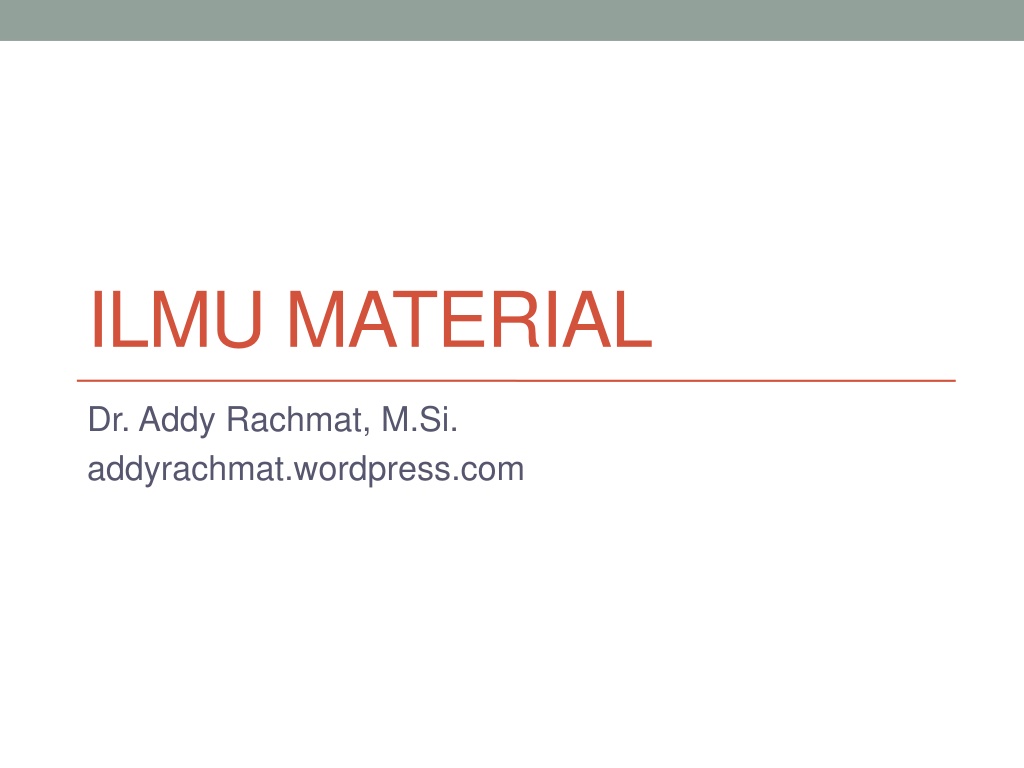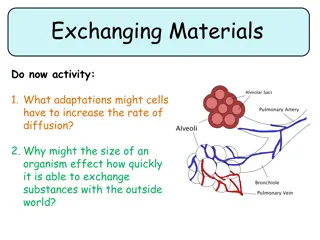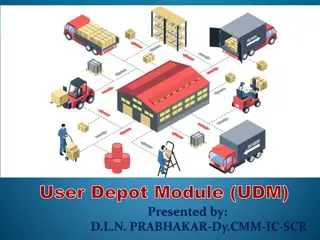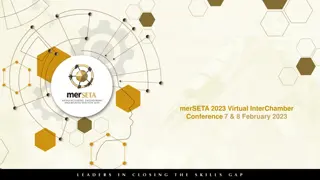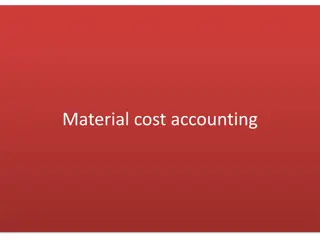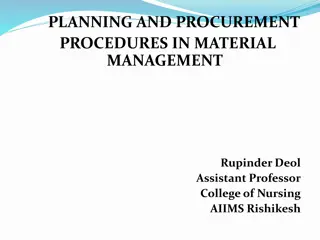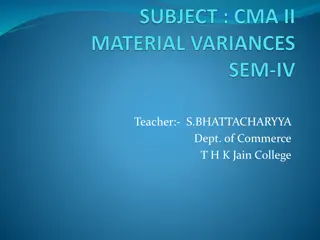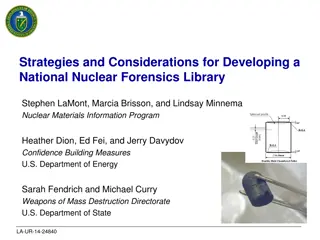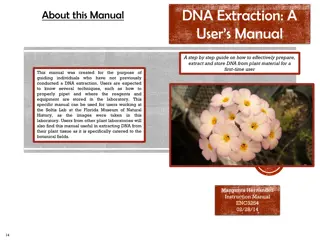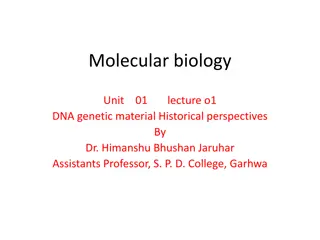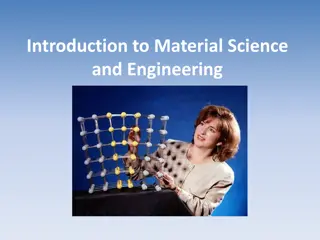ILMU MATERIAL
Life in the twenty-first century is heavily reliant on a diverse range of advanced materials, enriching our lives with convenience through technology. From microelectromechanical systems to materials chemistry, the field encompasses a broad spectrum of disciplines focused on material properties, synthesis, and prediction. Dive into the history and future directions of material science, tracing major developmental efforts from the ancient use of stone weapons to cutting-edge nanomaterial applications in the present day.
Download Presentation

Please find below an Image/Link to download the presentation.
The content on the website is provided AS IS for your information and personal use only. It may not be sold, licensed, or shared on other websites without obtaining consent from the author.If you encounter any issues during the download, it is possible that the publisher has removed the file from their server.
You are allowed to download the files provided on this website for personal or commercial use, subject to the condition that they are used lawfully. All files are the property of their respective owners.
The content on the website is provided AS IS for your information and personal use only. It may not be sold, licensed, or shared on other websites without obtaining consent from the author.
E N D
Presentation Transcript
ILMU MATERIAL Dr. Addy Rachmat, M.Si. addyrachmat.wordpress.com
Introduction Life in the twenty-first century is ever dependent on an unlimited variety of advanced materials We are spoiled by the technology that adds convenience to our lives, such as microwave ovens, laptop computers, digital cell phones, and improved modes of transportation The term material may be broadly defined as any solid- state component or device that may be used to address a current or future societal need Other more intangible materials such as nano devices may not yet be widely proven for particular applications, but will be essential for the future needs of our civilization.
Although this indicates sharp distinctions between various classes, there is often ambiguity regarding the proper taxonomy for a specific material (e.g. thin film, liquid crystals, hybrid composite) The broadly defined discipline of materials chemistry is focused on understanding the relationships between the arrangement of atoms, ions, or molecules comprising a material, and its overall bulk structural/physical properties By this designation, common disciplines such as polymer, solid-state, and surface chemistry would all be placed within the scope of materials chemistry. This broad field consists of studying the structures or properties of existing materials, synthesizing and characterizing new materials, and using advanced computational techniques to predict structures and properties of materials that have not yet been realized
Timeline of major developmental efforts related to materials science Electrical communication : telegraph, telephone ~1872 Glassblowing: eyeglasses, telescope, microscope, thermometers ~1774 Metallurgy : weaponry, cookware ~1.000 BC Stone/clay weaponry and shelter (~3.500 BC) Bone and animal skins (< 10.000 BC)
Timeline of major developmental efforts related to materials science Nano materials applications ~present Nano structural materials ~2002 Computational electronics ~1985 Automobiles ~1936 Polymers, fibres ~1885
Robo-cops go on patrol! Silicon Valley gets five foot tall robot security guards
Imagine a friend that can see, hear, feel and smell that would tirelessly watch over your corporate campus or neighbourhood, keep your loved ones safe and put a smile on everyone passing by. The five foot tall robots have a combination of laser scanning, wheel encoders, inertial measurements, and GPS that allows fully autonomous operation and charging. When on a patrolling duty, it uses lasers to calculate the distance and also relies on its GPS system It also has odour detectors, and can even monitor air pollution as it travels around. Using cameras they can also read up to 300 car number plates a minute, allowing them to monitor traffic Its inventors hope it could eventually patrol malls, office and even local neighbourhoods - and say they believe it will cut crime by 50%
Bottom-Up vs. Top-Down There are two rationales for the synthesis of materials top- down and bottom-up Transformation of complex natural products into desirable materials occurs primarily via atop-down approach (e.g., gemstones from naturally occurring mineral deposits, etching features on silicon wafers for chip production) The majority of synthetic materials are produced using the bottom-up approach This latter technique is the easiest to visualize, and is even practiced by children who assemble individual LEGO blocks into more complex architectures Indeed, the relatively new field of nanotechnology has drastically changed the conception of bottom-up processes, from the historical approach of combining or moulding bulk precursor compounds, to the self-assembly of individual atoms and molecules building
Illustrations for the top-down and bottom-up approach to materials synthesis. a) The top-down route is often used to transform naturally occurring products into useful materials. Representations shown include the conversion of wood into paper products, as well as certain golf ball covers. b) The bottom-up route of materials synthesis is most prevalent. The representation shown is the fabrication of plastics and vinyl found in common household products and automotive interiors, through polymerization processes starting from simple monomeric compounds
Critical thinking scheme for the design of a new material What property(ies) need to be improved/ developed? What is the target/need application? What materials are currently used for this application Method development based on past precedents (bottom- up/top-down, precursor design, synthetic pathways , choice of solvents , etc. Are there currently any materials under development with these desired properties? Evaluation of the structure vs. property relationship in similar materials Literature Search/Review
Revision of the synthetic pathway to improve properties, yield, purity, etc. Experiment with other starting materials, catalysts, etc. to see if a better procedure could be used Synthesis of the material, with suitable characterization (to prove it is what you think it is) Physical property measurements (does the material do what you anticipated?) File patent on the procedure, followed by publication of results in an appropriate scientific journal. Find licensor for technology, to scale-up production of the material
Objectives of Material Chemistry To provide an overview of the various types of materials, The overview will focus on synthetic methodologies To determine relationships between the structure of a material and its overall properties
Subjects covered Metals Semiconductors Polymeric Materials Nanomaterials
Related Topic: Solid State Chemistry Of the three states of matter, solids possess the most structural diversity. Whereas gases and liquids consist of discrete molecules that are randomly distributed due to thermal motion, solids consist of molecules, atoms, or ions that are statically positioned. To fully understand the properties of solid materials, one must have a thorough knowledge of the structural interactions between the subunit atoms, ions, and molecules
Amorphous vs Crystalline Solids A solid is a material that retains both its shape and volume over time. If a solid possesses long range, regularly repeating units, it is classified as a crystallinematerial. Crystalline solids are only produced when the atoms, ions, or molecules have an opportunity to organize themselves into regular arrangements, or lattices. For example, crystalline minerals found in nature have been formed through many years of extreme temperature and pressure, or slow evaporation processes Most naturally occurring crystalline solids comprise an agglomeration of individual microcrystalline units; single crystals without significant defects are extremely rare in nature, and require special growth techniques
If there is no long-range structural order throughout the solid, the material is best described as amorphous. Quite often, these materials possess considerable short-range order over distances of 1 10 nm or so. However, the lack of long range translational order (periodicity) separates this class of materials from their crystalline counterparts Since the majority of studies have been addressed to study crystalline solids relative to their amorphous counterparts, there is a common misconception that most solids are crystalline in nature. In fact, a solid product generated from many chemical reactions will be amorphous by default, unless special procedures are used to facilitate molecular ordering (i.e., crystal formation).
Although the crystalline state is more thermodynamically- favorable than the disordered state, the formation of amorphous materials is favored in kinetically bound processes (e.g., chemical vapor d position, sol-gel, solid precipitation, etc.). Some materials featuring extended networks of molecules such as glasses may never exist in the crystalline state. In these solids, the molecules are so entangled or structurally complex that crystallization may not occur as the temperature is slowly decreased. Due to the rigidity of the solid, but proclivity to remain in the amorphous state, these compounds have been incorrectly referred to as super-cooled liquids
Metals Of all the 115 elements listed in the Periodic Table, 70% exhibit metallic character. Since the discovery of copper and bronze by early civilizations, the study of metals (i.e., metallurgy) contributed to most of the early investigations related to materials science. Whereas iron-based alloys have long been exploited for a variety of applications, there is a constant search for new metallic compositions that have increasing structural durability, but also possess sufficiently less density The recent exploitation of titanium-based alloys results from this effort, and has resulted in very useful materials for applications ranging from aircraft bodies to hip replacements and golf clubs
Mining and Processing of Metals Before we examine the structures and properties of metallic classes in further detail, it is useful to consider the natural sources of the metals, generally as oxide and/or silicate-based mineral formations. If the mineral deposit contains an economically recoverable amount of a metal, it is referred to as an ore. The waste material of the rock formation is known as gangue, which must be separated from the desired portion of the ore through a variety of processing steps.
There are three main types of rocks, grouped according to their form of origin. Igneous rocks are those formed from the solidification of molten mass following volcanic activity. Common examples include granite, feldspar, mica, and quartz; metals such as the alkali and alkaline earths, gold, platinum, and chromium are isolated from these formations. Sedimentary rocks are those formed through compaction of small grains deposited as sediment in a riverbed or sea. Common examples include shale, limestone, sandstone, and dolomite.
Metals such as copper, iron, zinc, lead, nickel, molybdenum, and gold may all be found together within sulfur-based sedimentary deposits Metamorphicrocks are those formations that have changed composition and morphology over time through the influence of temperature and pressure. Examples of these rocks include marble, slate, gneiss, and yield similar metals as igneous formations. Most metals are obtained through physical and chemical modification of ores that contain a sufficiently high concentration of the desired metal
To obtain the ores in sufficient quantities needed to recover a desirable amount of metal, either open pit or shaft mining is used depending on how accessible the ore is located. Pit mining for metals such as copper, iron, and precious metals is commonly used throughout the US and Canada Once the ore is obtained from its deposit, the actual work of extracting the desired metal has yet to be accomplished. In addition to metals, a variety of other substances comprise natural minerals. Since aluminum and silicon are the most prevalent elements in the Earth s crust, most of the metals exist naturally as aluminates, silicates or aluminosilicates. The most common minerals are feldspars (comprising 60% of the Earth s crust) and clays. These materials have been used since ancient times for the production of materials such as pottery, brick, and china.
An example of a feldspar is K2Al2Si6O16, which corresponds to a mixture of potassium superoxide, alumina, and silica (K2O Al2O3 6SiO2). Upon contact with water and carbon dioxide, a weathering reaction results in kaolinite, an aluminosilicate clay (Eq. 1). However, in addition to these oxidized sources of metals, there are substances such as alkaline carbonates, sulfates, phosphates, as well as organic matter that need to be removed to yield the desired metal. As you would expect, the yield for this process is quite low; ores typically possess less than 1% of the desired metal! K2Al2Si6O16 + H2O + 2CO2 Al2Si2O7 + 2KHCO3 + 4SiO2
The most common mineral classes from which metals are extracted include: i. Silicates e.g., feldspars, quartz, olivines (Mg/Fe), pyroxenes (XY(Si, Al)2O6), garnets (X3Y2(SiO4)3), and micas (X2Y46Z8O20(OH, F)4) ii. Carbonates e.g., calcite and aragonite (both CaSO4), dolomite (Mg/Ca), siderite (Fe) iii. Sulfates e.g., anhydrite (CaSO4), celestine (SrSO4), barite, gypsum (hydrated CaSO4), chromate, molybdate, selenate, sulfite, tellurite, tungstate iv. Halides e.g., fluorite (CaF2), halite (NaCl), sylvite (KCl), sal ammoniac (NH4Cl)
v. Oxides e.g., hematite (Fe2O3), magnetite (Fe3O4), chromite (Fe/Cr), spinel (Mg/Al), ilmenite (Fe/Ti), rutile (TiO2) vi. Sulfides e.g., pyrite (FeS), chalcopyrite (Cu/Fe), pentlandite (Ni/Fe), galena (PbS), sulfosalt (S/As), selenide/telluride/arsenide/antimonide minerals vii. Phosphates e.g., AO4(A = P, As, Sb, V), apatite (Ca5(PO4)3(OH, F, Cl))
Extractive Metallurgy Mining ore from deposit Flotation process: separate metal from gaunge Grinding ore into powder and mixing it with water, oil and surfactant The mixture stirred into a frothy mixture coated grain attach themselves to air bubbles that float to the solution surface Skimming and filtration Smelting: the ore is heated in the presence of a reducing agent such as a carbonaceous material, or carbon monoxide Often, the ore is not pure following flotation; therefore, a flux such as limestone or dolomite is added to remove the gangue as slag a mixture of metal oxides (e.g., SiO2, Al2O3, CaO, MgO, etc.), sulfides and impurity metals
The temperature required for tin and lead smelting is only on the order of 300 400 C; hence, it is no surprise that early civilizations discovered these metals from heating local minerals over campfires, which yields a temperature of ca. 900 C. However, this temperature regime is not sufficient for copper smelting, which requires temperatures in excess of 1,100 C. Consequently, copper metal was most likely discovered serendipitously by using higher temperature coal-fired pottery kilns that contained the copper-rich mineral malachite.
